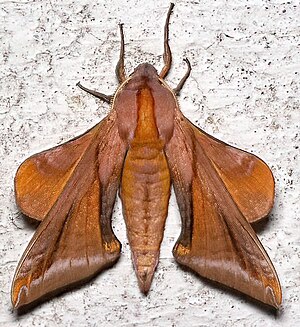Paonias astylus
| Paonias astylus | ||||||||||||
|---|---|---|---|---|---|---|---|---|---|---|---|---|

Paonias astylus |
||||||||||||
| Systematics | ||||||||||||
|
||||||||||||
| Scientific name | ||||||||||||
| Paonias astylus | ||||||||||||
| ( Drury , 1773) |
Paonias astylus is a butterfly ( moth ) from the family of moth (Sphingidae). Although the species is rather rare, it is one of the first swarm species to be described in North America.
features
butterfly
The moths have a fore wing length of 30 to 41 millimeters. You can distinguish them from the other species of the genus Paonias on the basis of the outer edge of the forewings, which is almost straight and not wavy only in this species. The moths are only variable in size and hardly in their color.
Caterpillar
The last stage of the caterpillars is similar to the other two North American species of the genus. They are lime green and have numerous white setae , which make the body surface appear very coarse. In the caterpillars of Paonias astylus , the reddish spots on the body are much less common than in Paonias myops and Paonias excaecata . The anal horn has a small double tip.
Doll
The pupa is reddish brown and has a slightly rough body, but is significantly less rough than in the two other North American species of the genus. The very short proboscis is fused with the body. The cremaster is quite long and narrow. It is not documented whether it ends in a single or double point, and there appears to be no drawing of the doll in the literature.
Occurrence
The species is common in the western United States. It occurs primarily in New England, but its distribution extends south to north-central Florida. To the west, the distribution extends over the southern part of the valley of the Ohio River and the valley of the Mississippi River . The species can be quite common in southeast Ohio, but further south there are only sporadic and isolated records. In Louisiana, for example, Brou & Brou found only 30 individuals up to 1997 during 25 years of intensive collection. It is believed that the species also occurs in the extreme south of Quebec, but the species has not yet been detected in Canada.
For reasons as yet unknown, populations of the species appear to be strongly tied to specific locations and may be absent from large parts of habitats that appear favorable to them. The animals are apparently bound to the undergrowth and the edges of trees with sandy bottoms in the eastern United States. These dry habitats with vegetation of various heather plants seem to be ideal for the species.
Way of life
Adults are only occasionally and never often observed in artificial light sources. Like the other representatives of the genus, the moths cannot eat.
In the northeastern United States, the Ohio River valley and large parts of the Appalachian Mountains , the species occurs in only one generation per year in midsummer. There is little evidence from the south, so the flight time is insufficiently known. There appear to be two generations in Florida that fly in late spring and late summer. In Louisiana, the species is found almost exclusively from July to September.
Food of the caterpillars
The caterpillars apparently feed exclusively on the heather family (Ericaceae). They are found in New England on blueberries ( Vaccinium ), Gaylussacia and rosemary heather ( Andromeda ). In the literature there are also isolated records of plant species from other families, but this is apparently due to incorrect determinations.
development
The females lay their eggs individually on the tips of the leaves of the host plants. The caterpillars are loners. Pupation takes place in a chamber in the ground very close to the surface.
supporting documents
Individual evidence
- ↑ a b c d e f g h i j James P. Tuttle: The Hawkmoths of North America, A Natural History Study of the Sphingidae of the United States and Canada. The Wedge Entomological Research Foundation, Washington, DC 2007, ISBN 978-0-9796633-0-7 , pp. 122f.
literature
- James P. Tuttle: The Hawkmoths of North America, A Natural History Study of the Sphingidae of the United States and Canada. The Wedge Entomological Research Foundation, Washington, DC 2007, ISBN 978-0-9796633-0-7 .

